Discover 35 hidden attractions, cool sights, and unusual things to do in Birmingham (United States). Don't miss out on these must-see attractions: Sloss Furnaces National Historic Landmark, Vulcan statue, and Linn Park. Also, be sure to include Birmingham Museum of Art in your itinerary.
Below, you can find the list of the most amazing places you should visit in Birmingham (Alabama).
Table of Contents
Sloss Furnaces National Historic Landmark
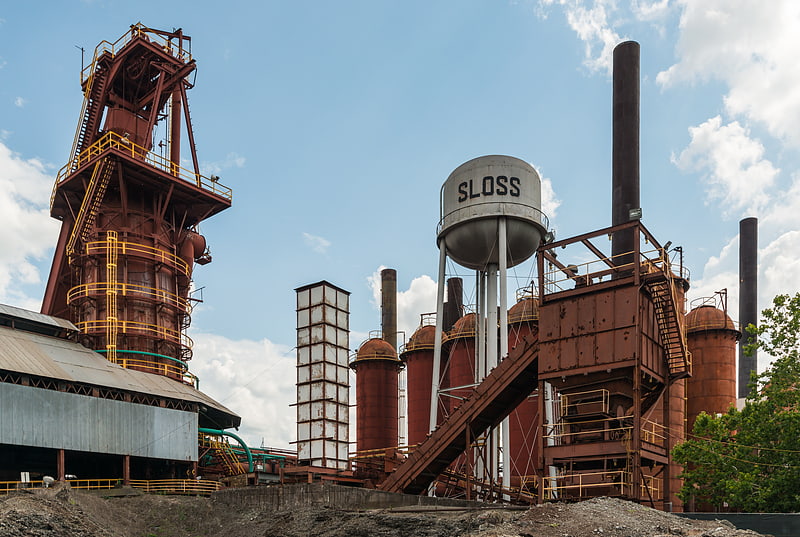
Local history museum in Birmingham, Alabama. Sloss Furnaces is a National Historic Landmark in Birmingham, Alabama in the United States. It operated as a pig iron-producing blast furnace from 1882 to 1971. After closing, it became one of the first industrial sites in the U.S. to be preserved and restored for public use. In 1981, the furnaces were designated a National Historic Landmark by the United States Department of the Interior.
The site currently serves as an interpretive museum of industry and hosts a nationally recognized metal arts program. It also serves as a concert and festival venue. A new visitor center was built 2015 and opened in 2016. The furnace site, along a wide strip of land reserved in Birmingham's original city plan for railroads and industry, hosts thousands of students through their education programs per year. The museum is free to visit during their operating hours of Tuesday-Saturday 10:00 A.M to 4:00 P.M.[1]
Address: 20 32nd St N, 35222 Birmingham (Northside)
Vulcan statue
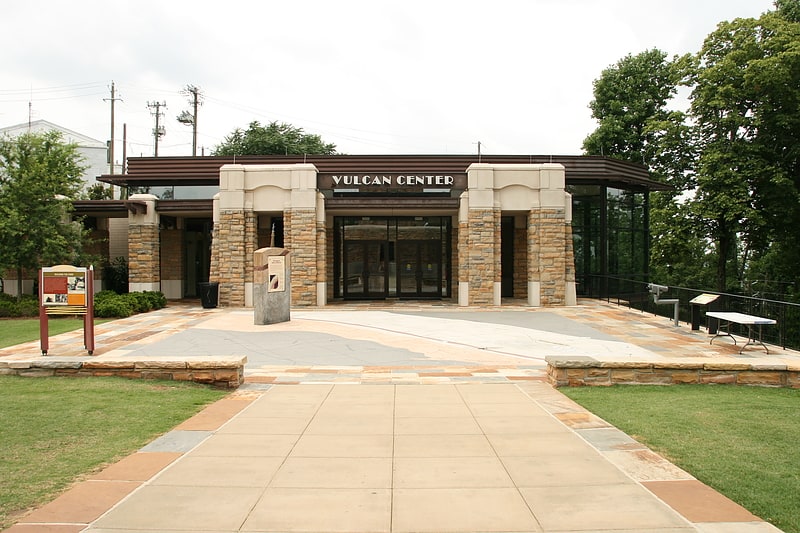
Statue by Giuseppe Moretti. The Vulcan statue is the largest cast iron statue in the world, and is the city symbol of Birmingham, Alabama, reflecting its roots in the iron and steel industry. The 56-foot tall statue depicts the Roman god Vulcan, god of the fire and forge, with ironworking equipment. It was created as Birmingham's entry for the Louisiana Purchase Exposition in St. Louis, Missouri. While it is the world's largest made of iron, it is also among the nation's tallest statues of any kind.[2]
Address: 1701 Valley View Dr, 35209 Birmingham
Linn Park
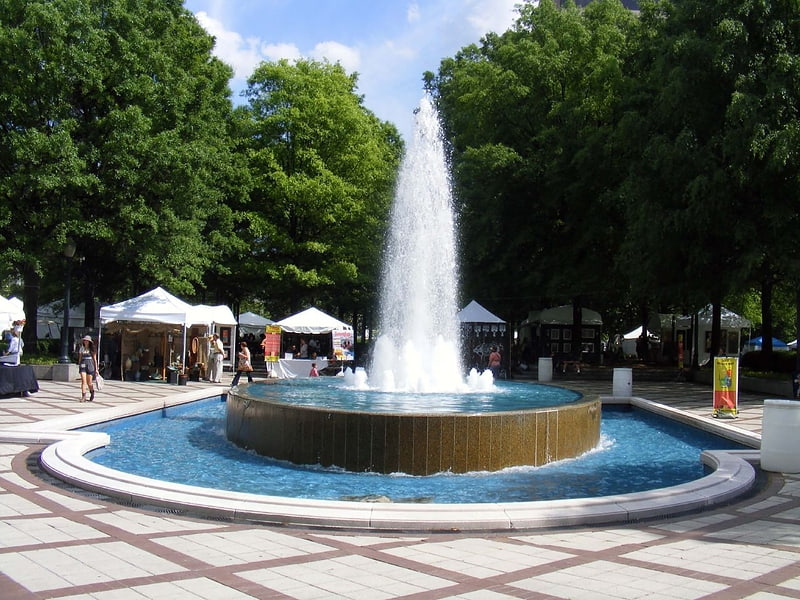
Park in Birmingham, Alabama. Linn Park is a seven-acre urban park in the centre of Birmingham, Alabama. It is overlooked by Birmingham City Hall. Formerly known as Capitol Park, Woodrow Wilson Park, and Central Park, the park was renamed after Confederate naval officer and businessman Charles Linn in the 1980s.[3]
Address: 710 20th St N, 35203-2216 Birmingham (Northside)
Birmingham Museum of Art
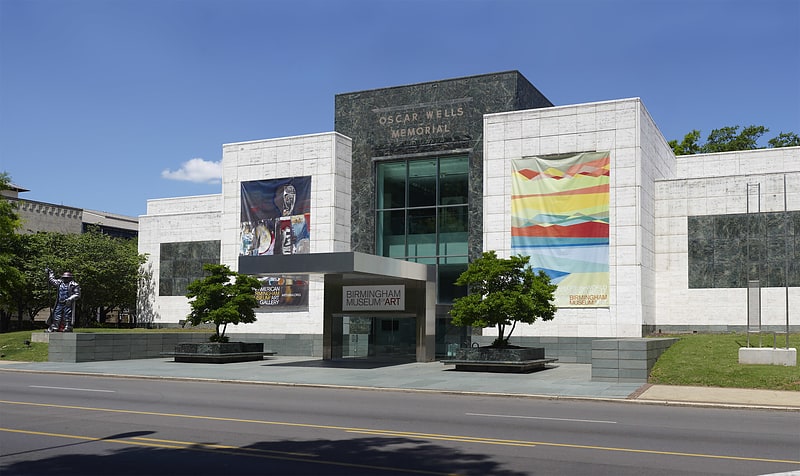
Museum in Birmingham, Alabama. The Birmingham Museum of Art is a museum in Birmingham, Alabama. It has one of the most extensive collections of artwork in the Southeastern United States, with more than 24,000 paintings, sculptures, prints, drawings, and decorative arts representing numerous cultures, including Asian, European, American, African, Pre-Columbian, and Native American. Among other highlights, the museum's collection of Asian art is considered the finest and most comprehensive in the Southeast, and its Vietnamese ceramics one of the finest in the US. The museum also is home to a collection of Renaissance and Baroque paintings, sculpture, and decorative arts from the late 13th century to c.1750.
The Birmingham Museum of Art is owned by the City of Birmingham and encompasses 3.9 acres (16,000 m2) in the heart of the city’s cultural district. Erected in 1959, the present building was designed by architects Warren, Knight and Davis, and a major renovation and expansion by Edward Larrabee Barnes of New York was completed in 1993. The facility encompasses 180,000 square feet (17,000 m2), including an outdoor sculpture garden.
The museum is part of the Monuments Men and Women Museum Network, launched in 2021 by the Monuments Men Foundation for the Preservation of Art.[4]
Address: 2000 Reverend Abraham Woods Jr Boulevard, 35203-2205 Birmingham (Northside)
16th Street Baptist Church
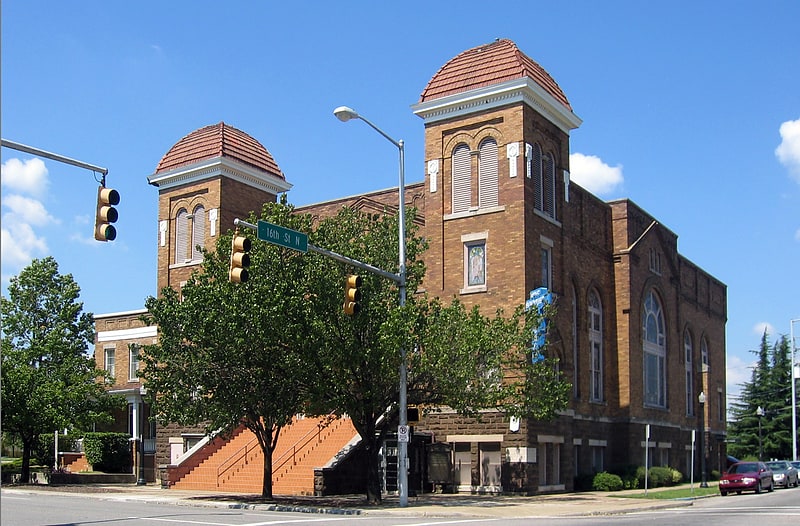
Baptist church in Birmingham, Alabama. The 16th Street Baptist Church is a Baptist church in Birmingham, Alabama, United States. In 1963, the church was bombed by Ku Klux Klan members. The bombing killed four young girls in the midst of the Civil Rights Movement. The church is still in operation and is a central landmark in the Birmingham Civil Rights District. It was designated as a National Historic Landmark in 2006. Since 2008, it has also been on the UNESCO list of tentative World Heritage Sites.[5]
Address: 1530 6th Ave N, 35203 Birmingham (Northside)
Legacy Arena
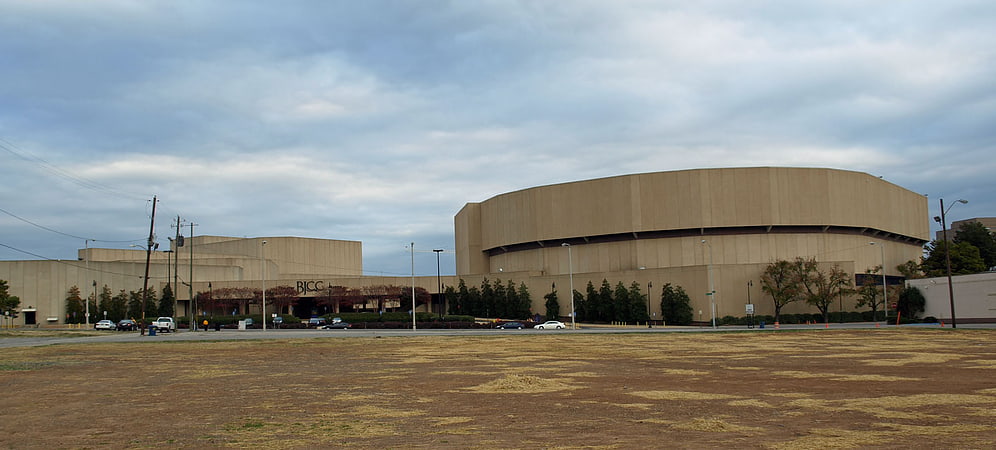
Sports complex in Birmingham, Alabama. The Birmingham–Jefferson Convention Complex is a sports, convention and entertainment complex located in Birmingham, Alabama. The Sheraton Birmingham and Westin Birmingham are located on the complex adjoining the convention center. Alongside numerous exhibit halls, meeting and ballrooms, the complex features four entertainment venues: a stadium, an arena, concert hall, and theater.[6]
Address: 2101 Richard Arrington Jr Blvd N, 35203-1101 Birmingham (Northside)
Birmingham Zoo
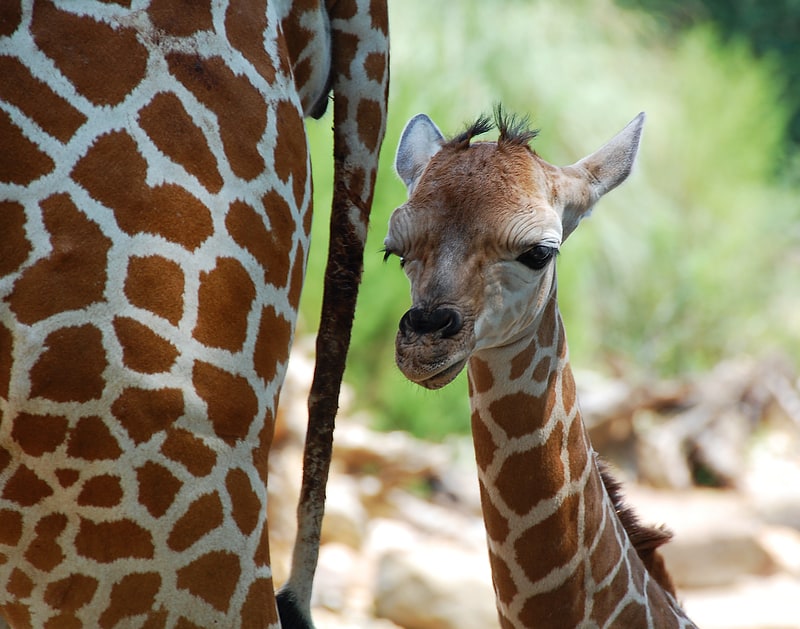
Hundreds of animals and endangered species. The Birmingham Zoo is a zoological park that opened in 1955 in Birmingham, Alabama, United States.
The Birmingham Zoo is an independent, not for profit, 501(c)(3) organization, and is accredited by the Association of Zoos and Aquariums (AZA), participating in AZA Species Survival Plans (SSP). It is both the only AZA accredited coo and the lowest paying zoo in the state of Alabama.
Approximately 550 animals of 195 species call the Birmingham Zoo home, including sea lions, zebras, rhinos, elephants, and other endangered species from six continents.[7]
Address: 2630 Cahaba Rd, 35223-1154 Birmingham (Red Mountain)
Regions Field
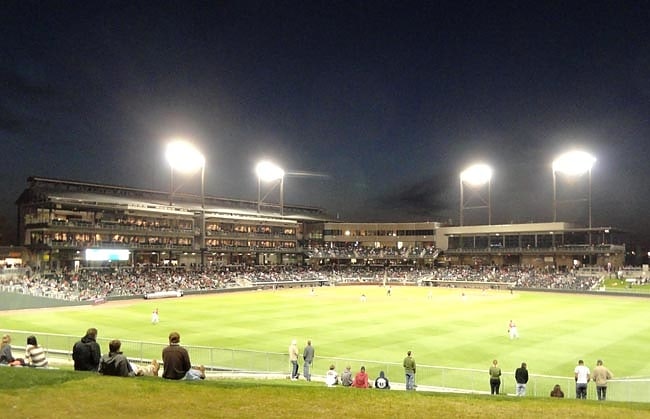
Stadium in Birmingham, Alabama. Regions Field is the name of a minor league baseball park in the Southside community of Birmingham, Alabama, U.S. It is the home field for the Birmingham Barons of the Double-A South, and replaced Hoover Metropolitan Stadium in the Birmingham suburb of Hoover as their home field. It also serves as the second home field along with Jerry D. Young Memorial Field for the UAB Blazers. Regions Field is located adjacent to the Railroad Park, just south of downtown Birmingham.
Baseball in Birmingham traces its history to 1885 with the establishment of the original Barons, and from 1910 to 1987, professional baseball teams called Rickwood Field home. In 1988, the Barons moved to Hoover Metropolitan Stadium, leaving the city of Birmingham without professional baseball. In 2009, a proposal surfaced to build a downtown stadium to bring baseball back to Birmingham. After a feasibility study was completed, in October 2010, the city lodging tax was increased to finance its construction and in November 2010, a tentative agreement was reached to bring the Barons back to Birmingham. Groundbreaking ceremonies were held for the new facility on February 2, 2012, and the park celebrated its grand opening on April 10, 2013.[8]
Address: 1401 1st Ave S, 35233-1503 Birmingham
Birmingham Civil Rights Institute
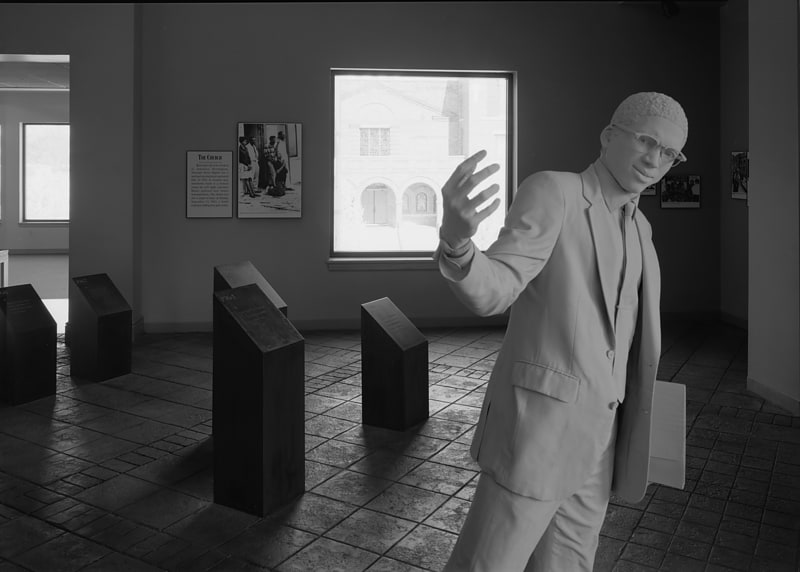
Museum in Birmingham, Alabama. Birmingham Civil Rights Institute is a large interpretive museum and research center in Birmingham, Alabama that depicts the struggles of the Civil Rights Movement in the 1950s and 1960s. The Institute is located in the Civil Rights District, which includes the historic 16th Street Baptist Church, Kelly Ingram Park, Fourth Avenue Business District, and the Alabama Jazz Hall of Fame located in the Carver Theatre. The Institute opened in November 1992, and had more than 25,000 visitors during its first week.[9]
Address: 520 16th St N, 35203-1911 Birmingham (Northside)
Rotary Trail
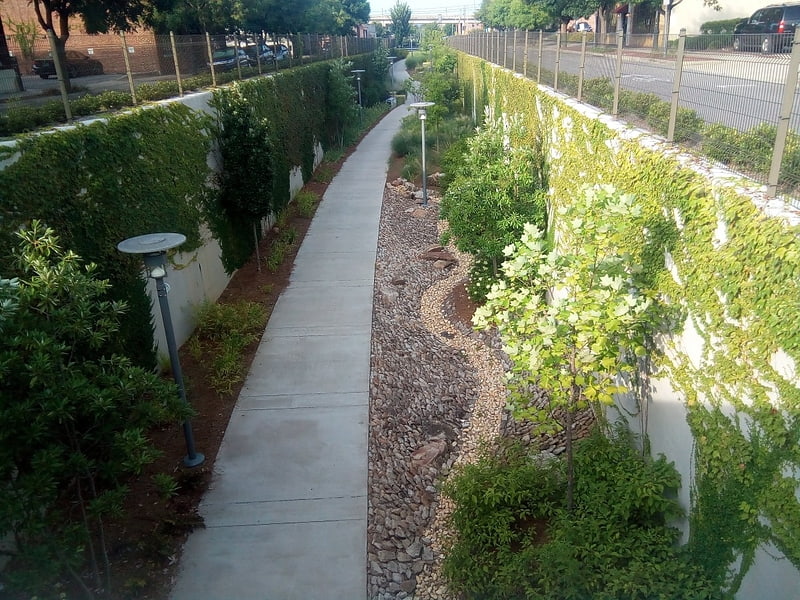
Rotary Trail is a half-mile linear park in downtown Birmingham, Alabama. The trail was predominantly funded by the Birmingham Rotary Club in honor of their centennial anniversary. The trail runs from 20th Street to 24th Street along First Avenue South and connects two major downtown areas: the 19-acre Railroad Park on one side, and Sloss Furnaces, a National Historic Landmark, on the other side. It opened in 2016.
The entrance to the trail has a 46-foot-tall sign that reads, "Rotary Trail in the Magic City." The sign was modeled after the historical "Birmingham the Magic City" sign that previously existed in the city.[10]
Woodlawn City Hall
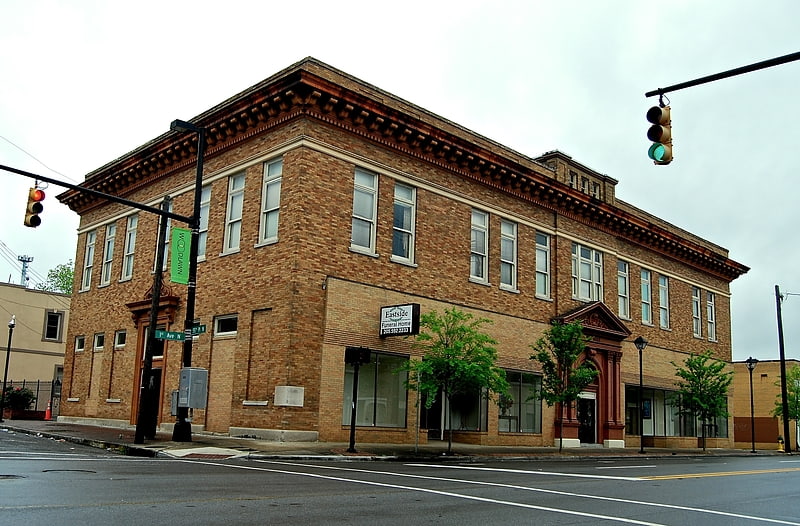
The Woodlawn City Hall, at 5525 First Ave. N, in Birmingham, Alabama, was built in 1908. It was listed on the National Register of Historic Places in 1988. It is also one of 12 contributing buildings in the Woodlawn Commercial Historic District, and one of 608 contributing buildings in larger Woodlawn Historic District.
It is a two-story building.
It served as city hall of independent Woodlawn, Alabama for only two years, before the city was incorporated into Birmingham. It included "most of the town's public functions within its walls— city offices, the court and jail, the fire department, an auditorium for meetings and performances, and the first branch of the Greater Birmingham Library, which began with 890 books. Relieved of its city hall status after the annexation, the upstairs became used entirely by the Library (they did not build separate quarters until 1950), while the street level was converted on one side to retail spaces, the longest-term occupant of which was the Morgan Brothers Department Store. The fire station remained until 1928, and subsequently that half of the first floor was converted to commercial use. The City of Birmingham did not sell the Woodlawn City Hall to private interests until 1940."[11]
Birmingham Botanical Gardens

Botanical garden in Birmingham, Alabama. The Birmingham Botanical Gardens is 67.5-acre of botanical gardens located adjacent to Lane Park at the southern foot of Red Mountain in Birmingham, Alabama. The gardens are home to over 12,000 different types of plants, 25 unique gardens, more than 30 works of original outdoor sculpture, and several miles of walking paths. With more than 350,000 annual visitors, the Birmingham Botanical Gardens qualify as one of Alabama's top free-admittance tourist attractions.
The gardens include a garden center that has a library (the largest public horticulture library in the U.S.), auditorium, Linn-Henley Lecture Hall, Blount Education Center, Gerlach Plant Information Center, Alabama Cooperative Extension System office, Arrington Children's Plant Adventure Zone, and a restaurant.[12]
Address: 2612 Lane Park Rd, 35223-1800 Birmingham (Red Mountain)
McWane Science Center

Museum in Birmingham, Alabama. The McWane Science Center is a science museum and research archive located in downtown Birmingham, Alabama, United States. The state-of-the-art science center, aquarium, and 280-seat IMAX Dome Theater is housed in the historic and refurbished Loveman's department store building. It opened to the public on July 11, 1998.
On the lower level, the World of Water exhibit showcases more than 50 species of marine and freshwater aquatic life. There is a touch tank with different species of small sharks and rays. There are also shark teeth that can be observed under a microscope and different displays about water pollution.
The Alabama Collections Center (on the second floor) is the home of more than 500,000 items from the former Red Mountain Museum. The center houses precious minerals, fossils, and Native American artifacts, the most noteworthy including the world's fourth-largest collection of mosasaurs; the Appalachiosaurus (similar to Tyrannosaurus); and the state fossil of Alabama, the Basilosaurus cetoides (an 80-foot (24 m) fossil whale).
For smaller children there is the Itty Bitty Magic City exhibit (on the second floor), featuring a climbing structure, a water play area, an area specifically for toddlers, and an area with smaller versions of common buildings in a city. The model buildings are all made to help younger children learn skills, or to connect with their parents. One example is a model grocery store where children can learn about the main food groups while "shopping" with their parents. The exhibit opened on May 16, 2015, and was a remodeling of an older early childhood play place with the same name previously located on the third floor.
The McWane Science Center is named after the McWane family and McWane, Inc. both of which helped fund the center.[13]
Address: 200 19th St N, 35203 Birmingham (Northside)
Legion Field

Stadium in Birmingham, Alabama. Legion Field is an outdoor stadium in the southeastern United States in Birmingham, Alabama, primarily designed to be used as a venue for American football, but occasionally used for other large outdoor events. Opened in 1927, it is named in honor of the American Legion, a U.S. organization of military veterans.
Since the removal of the upper deck in 2004, Legion Field has a seating capacity of approximately 71,594. At its peak, it seated 83,091 for football and had the name "Football Capital of the South" emblazoned from the facade on its upper deck. Legion Field is colloquially called "The Old Gray Lady" and "The Gray Lady on Graymont".[14]
Address: 400 Graymont Ave W, 35204-4008 Birmingham
Rickwood Field

Playing field in Birmingham, Alabama. Rickwood Field, located in Birmingham, Alabama, is the oldest professional baseball park in the United States. It was built for the Birmingham Barons in 1910 by industrialist and team-owner Rick Woodward and has served as the home park for the Birmingham Barons and the Birmingham Black Barons of the Negro leagues. Though the Barons moved their home games to the Hoover Met in the suburbs, and most recently to Regions Field in Birmingham, Rickwood Field has been preserved and is undergoing gradual restoration as a "working museum" where baseball's history can be experienced. The Barons also play one regular season game a year at Rickwood Field. Rickwood Field is listed on the National Register of Historic Places.[15]
Address: 1137 2nd Ave W, 35204-4502 Birmingham (West End)
Alabama Theatre

Theatre in Birmingham, Alabama. The Alabama Theatre is a movie palace in Birmingham, Alabama. It was built in 1927 by Paramount's Publix Theatre chain as its flagship theater for the southeastern region of the United States. Seating 2,500 people at the time, it was the largest in the Birmingham Theatre district. The district was once home to a myriad of large theaters that featured vaudeville, performing arts, nickelodeons, and large first-run movie palaces. The Alabama is the only district theater still operating today. Built to show silent films, the Alabama still features its original Wurlitzer theater organ. Other than the Alabama, the Lyric Theatre is the only theater still standing in the district.
The Alabama and its historic organ were added to the Alabama Register of Landmarks and Heritage on February 15, 1977, and to the National Register of Historic Places on November 13, 1979. The theater has been surveyed by the Historic American Buildings Survey on several occasions, the last time being in 1996. It was designated as the state's historic theater in 1993.[16]
Address: Birmingham, 1817 Third Avenue North
Alabama Sports Hall of Fame

Museum in Birmingham, Alabama. The Alabama Sports Hall of Fame is a state museum located in Birmingham, Alabama, dedicated to communicating the state’s athletic history. The museum displays over 5,000 objects related to athletes who were born in Alabama or earned fame through athletics that reflects positively upon the state, usually through excellence at an educational institution or sporting event in Alabama. The ASHOF was established by state legislative act on August 14, 1967.[17]
Address: 2150 Richard Arrington Jr Blvd N, 35203 Birmingham (Northside)
Cathedral of Saint Paul
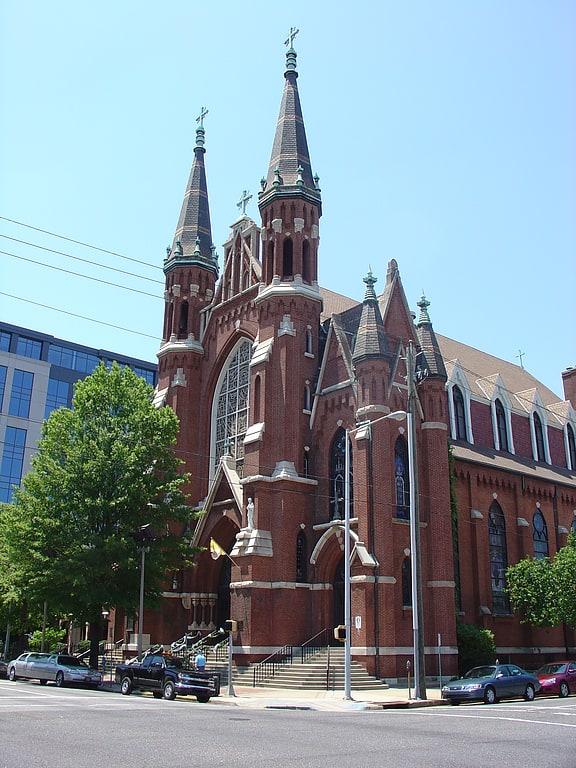
Cathedral in Birmingham, Alabama. The Cathedral of Saint Paul — informally known as Saint Paul's Cathedral — is the mother church of the Roman Catholic Diocese of Birmingham in Alabama in Birmingham, Alabama. Designed by Chicago architect Adolphus Druiding, the Victorian Gothic-style brick building was completed as a parish church in 1893. The parish it serves was established in 1872 and the cornerstone bears both dates. It was elevated to cathedral status with the creation of the Diocese of Birmingham in 1969.
During its days as a parish, its most famous pastor was Father James Coyle. There is the aspiration of relocating his remains from Elmwood Cemetery to the cathedral as the cause for his beatification as a martyr advances.
The contractor that had to be talked into moving to Birmingham to build the project was Lawrence Scully. Just prior to its completion, Lawrence Scully was killed when his horse-drawn carriage was spooked by a passing motor vehicle that honked its horn. The horse reared and flipped the carriage over, killing Lawrence Scully. Lawrence Scully also built one of Birmingham's first public schools, the Powell School.
Two buildings, the church and associated school, were listed on the National Register of Historic Places as St. Paul's Catholic Church in 1982.
The stained-glass windows in the cathedral's aisles are the work of G. C. Riordan & Company of Cincinnati. They were in place when the church was first used. The large window of St. Paul over the entrance was installed in 1972, replacing an older window that had been damaged in a storm.[18]
Address: 2120 3rd Ave N, 35203 Birmingham (Northside)
Kelly Ingram Park
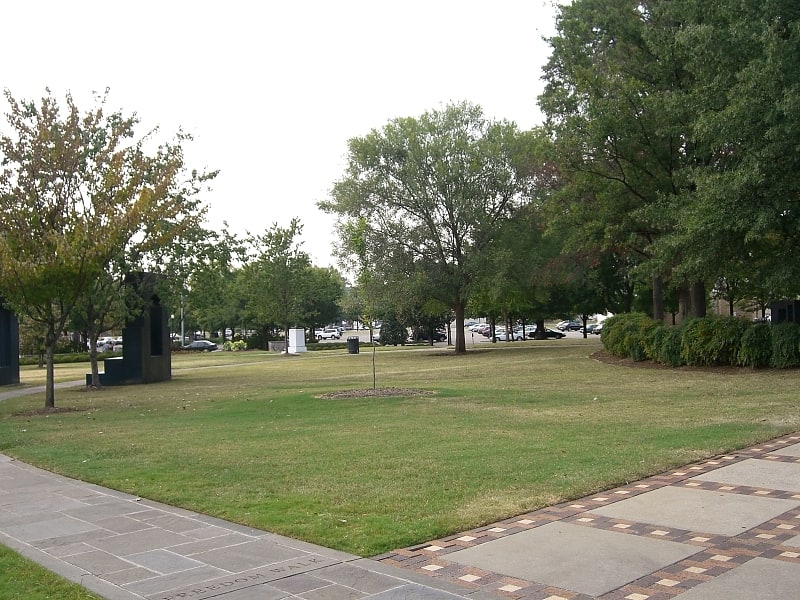
Park in Birmingham, Alabama. Kelly Ingram Park, formerly West Park, is a 4 acres park located in Birmingham, Alabama. It is bounded by 16th and 17th Streets and 5th and 6th Avenues North in the Birmingham Civil Rights District. The park, just outside the doors of the 16th Street Baptist Church, served as a central staging ground for large-scale demonstrations during the American Civil Rights Movement of the 1960s.
Reverend James Bevel of the Southern Christian Leadership Conference directed the organized protest by students in 1963 which centered on Kelly Ingram Park. It was here, during the first week of May 1963, that Birmingham police and firemen, under orders from Public Safety Commissioner Eugene "Bull" Connor, confronted the student demonstrators, almost all of them children and high school students, first with mass arrests and then with police dogs and firehoses. Images from those confrontations, broadcast internationally, spurred a public outcry which turned the nation's attention to the struggle for racial equality. The demonstrations in Birmingham brought city leaders to agree to an end of public segregation and helped to ensure the writing and then the passage of the Civil Rights Act of 1964.
The park was named in 1932 for local firefighter Osmond Kelly Ingram, who was the first sailor in the United States Navy to be killed in World War I. In 1992 it was completely renovated and rededicated as "A Place of Revolution and Reconciliation" to coincide with the opening of the Birmingham Civil Rights Institute, an interpretive museum and research center, which adjoins the park to the west.
The park is the setting for several pieces of sculpture related to the civil rights movement.
There is a central fountain and commemorative statues of Dr. Martin Luther King Jr. Rev. Fred Shuttlesworth, and some of the other heroes of the civil rights movement, as well as three installations by artist James Drake which flank a circular "Freedom Walk". They bring the visitor inside the portrayals of terror and sorrow of the 1963 confrontations. A limestone sculpture by Raymond Kaskey depicts three ministers, John Thomas Porter, Nelson H. Smith, and A. D. King, kneeling in prayer.
The Four Spirits sculpture was unveiled at Kelly Ingram Park on September, 2013 to commemorate the 50th anniversary of the 16th Street Baptist Church bombing. Crafted in Berkeley, California by Birmingham-born sculptor Elizabeth MacQueen and designed as a memorial to the four girls killed in the bombing (which occurred on September 15, 1963), it depicts the four girls in preparation for the church sermon at the 16th Street Baptist Church in the moments immediately before the explosion. The youngest girl killed in the explosion (Carol Denise McNair) is depicted releasing six doves into the air as she stands tiptoed and barefooted upon a bench as another barefooted girl (Addie Mae Collins) is depicted kneeling upon the bench, affixing a dress sash to McNair; a third girl (Cynthia Wesley) is depicted sitting upon the bench alongside McNair and Collins with a book in her lap. The book depicts the refrain of William Butler Yeats poem "The Stolen Child". The fourth girl (Carole Robertson) is depicted standing and smiling as she motions the other three girls to attend their church sermon. At the base of the sculpture is an inscription of the name of the sermon the four girls were to attend prior to the bombing—"A Love that Forgives." Oval photographs and brief biographies of the four girls killed in the explosion, the most seriously injured survivor (Sarah Collins), and the two teenage boys shot to death later that day also adorn the base of the sculpture.
Additional monuments honor Pauline Fletcher, Carrie A. Tuggle, Ruth Jackson, Arthur Shores, Julius Ellsberry, and the "foot soldiers" and other "unsung heroes" of the Civil Rights Movement.
The park hosts several local family festivals and cultural and entertainment events throughout the year. The Civil Rights Institute provides audio-tour guides for the park which feature remembrances by many of the figures directly involved in the confrontations. Urban Impact, Inc. also provides guided tours by appointment.[19]
Address: 551-599 16th St N, 35203 Birmingham (Northside)
Southern Museum of Flight
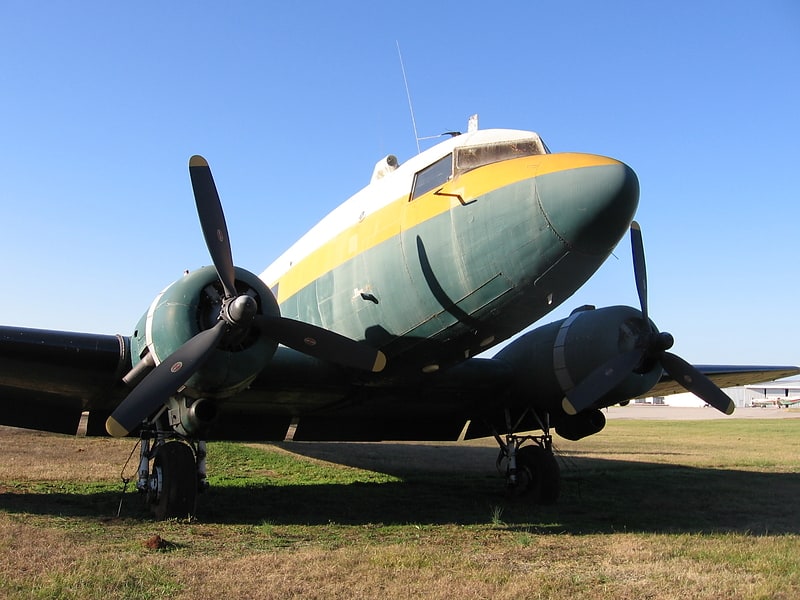
Museum in Birmingham, Alabama. The Southern Museum of Flight is a civilian aviation museum Birmingham, Alabama. The facility features nearly 100 aircraft, as well as engines, models, artifacts, photographs, and paintings. In addition, the Southern Museum of Flight is home to the Alabama Aviation Hall of Fame, which presents Alabama Aviation History through collective biography.[20]
Address: 4343 73rd St N, 35206-3642 Birmingham (East Lake)
Ruffner Mountain Nature Center
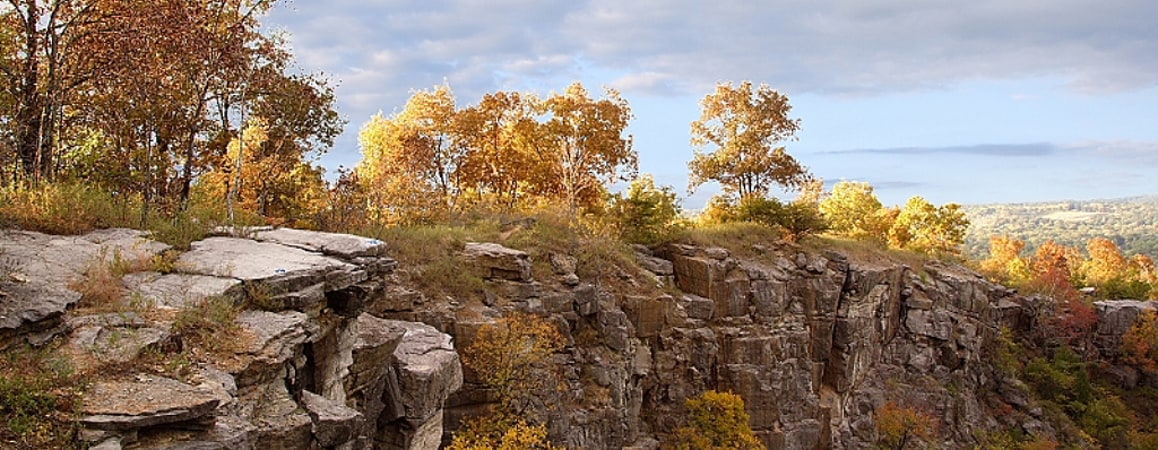
Nature preserve in Jefferson County, Alabama. Ruffner Mountain Nature Preserve is a 1,038 acre nature preserve located in the eastern portion of Jefferson County, Alabama in the City of Birmingham's historic South East Lake neighborhood. The preserve includes a visitor center containing native Alabama animals including raptors, snakes, turtles, and owls. The Ruffner Mountain area was home to iron ore mines and stone quarries, supplying the area's steel mills.
The preserve contains more than 14 miles (23 km) of hiking trails.[21]
Address: 1214 81st St S, 35206-4599 Birmingham (Roebuck - South East Lake)
Alabama Jazz Hall of Fame
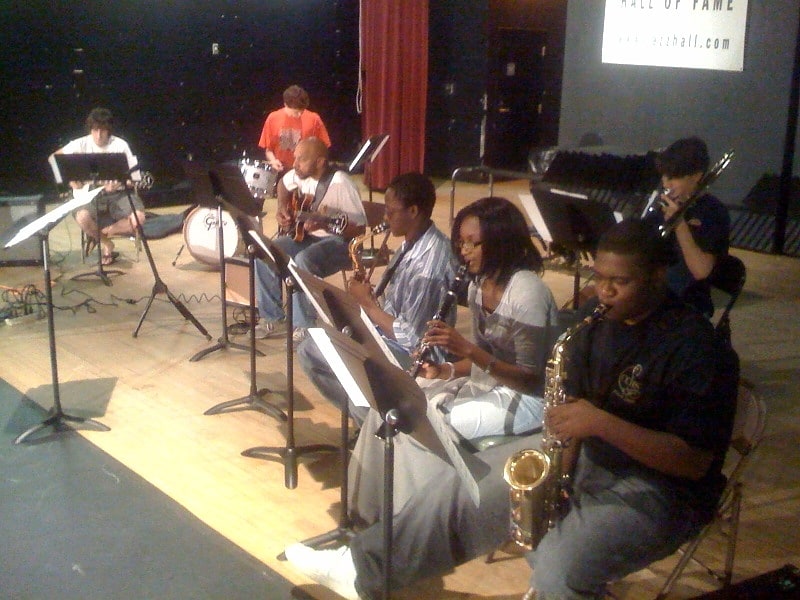
Museum in Birmingham, Alabama. The Alabama Jazz Hall of Fame was founded in 1978, and opened a museum on September 18, 1993, with a mission "to foster, encourage, educate, and cultivate a general appreciation of the medium of jazz music as a legitimate, original and distinctive art form indigenous to America. Its mission is also to preserve a continued and sustained program of illuminating the contribution of the State of Alabama through its citizens, environment, demographics and lore, and perpetuating the heritage of jazz music." It is located in Birmingham, Alabama, United States.[22]
Address: 1701 4th Ave N, 35203 Birmingham (Northside)
Oak Hill Cemetery
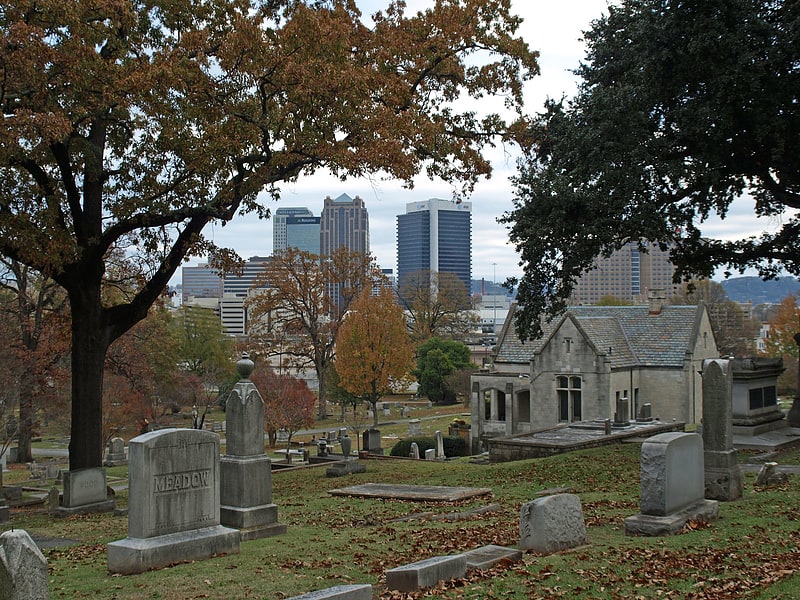
Cemetery. Oak Hill Cemetery, located just north of downtown, is Birmingham, Alabama's oldest cemetery. Originally 21.5 acres on the estate of James M. Ware, it was already a burial ground by April 1869 when it served as the resting place for the infant daughter of future mayor Robert H. Henley. It was marked as "City Cemetery" on the original plats for Birmingham laid out by the Elyton Land Company and was formally sold to the city on December 29, 1873 for the sum of $1,073.50.
Most of the 10,000 or so burials at Oak Hill were interred before 1930, including nine of the ten landholders who founded the city, many early mayors, a Revolutionary soldier, numerous American Civil War veterans, and the first male child born in the city. Although few records exist from the time, most believe the "Potter's Field" section was also used as the final resting place for many victims of the 1873 cholera epidemic.
In 1889 Judge A. O. Lane purchased 200 acres (0.8 km2) on the southern slopes of Red Mountain (Birmingham, Alabama), now Lane Park, for the burial of paupers, thereby ending the use of Oak Hill's "Potter's Field". In 1928 the caretaker's cottage near the center of the property, was removed to the southwest corner of the cemetery and a new "Pioneer's Memorial Building" was constructed of Indiana limestone, designed by Miller & Martin Architects with William Kessler, landscape architect.
In 1977, Oak Hill Cemetery was added to the National Register of Historic Places. The Oak Hill Memorial Association keeps an office in the former caretaker's cottage and published a quarterly newsletter, the Oak Hill Pioneer, from Winter 1999 to Fall 2006, with articles about the history of the city in the context of the lives of those buried at Oak Hill.[23]
Address: 1120 19th St N, 35234-2511 Birmingham (Northside)
Arlington Antebellum Home and Gardens
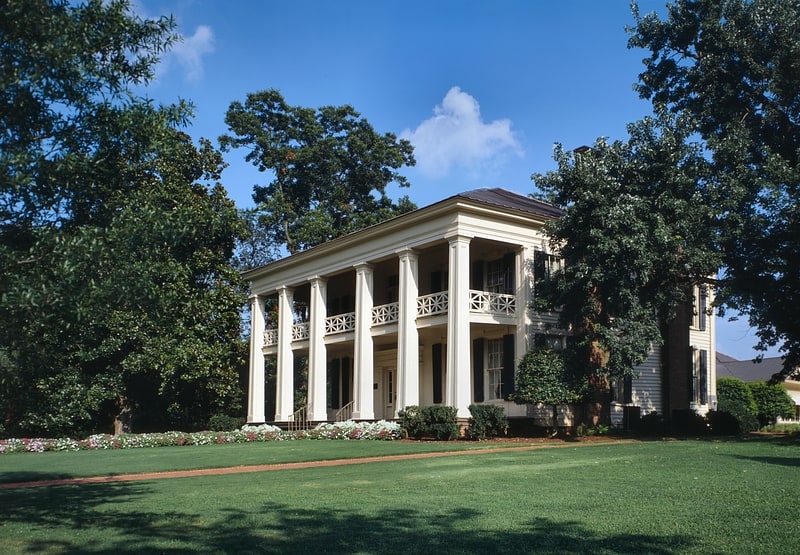
Arlington Antebellum Home & Gardens, or Arlington Historic House, is a former plantation house and 6 acres of landscaped gardens near downtown Birmingham, Alabama. The two-story frame structure was built between 1845–50 and features antebellum-era Greek Revival architecture. The house serves as a decorative arts museum, featuring a collection of 19th-century furniture, textiles, silver, and paintings. The garden features a restored garden room that is used for special events. The house was added to the National Register of Historic Places on December 2, 1970, as Arlington, and has also been known as the Mudd-Munger House.[24]
Address: 331 Cotton Ave SW, 35211-1465 Birmingham (West End)
Carver Theatre
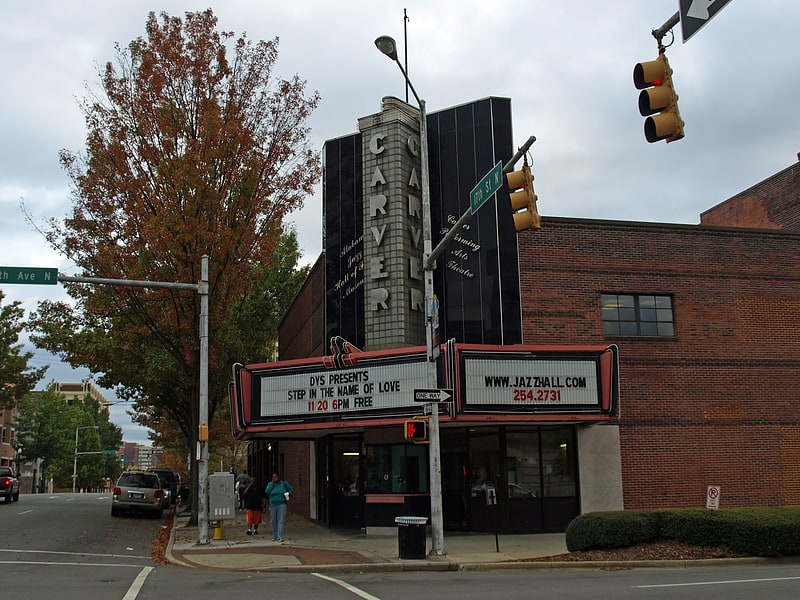
Theatre in Birmingham, Alabama. The Carver Theatre, now formally known as the Carver Performing Arts Center, is a theater located in downtown Birmingham, Alabama. In its days as a motion picture theater, it was best known as a place where African-Americans could see first-run movies; during that time, only whites were allowed in most theaters because of segregation laws.
The Carver is now a live performance venue which seats 527, and is also the home of the Alabama Jazz Hall of Fame.[25]
Address: 1631 4th Ave N, 35203-1903 Birmingham (Northside)
Birmingham Civil Rights District

The Birmingham Civil Rights District is an area of downtown Birmingham, Alabama where several significant events in the Civil Rights Movement of the 1950s and 1960s took place. The district was designated by the City of Birmingham in 1992 and covers a six-block area.
Landmarks in the district include:
- 16th Street Baptist Church, where the students involved in the 1963 Children's Campaign were trained and left in groups of 50 to march on City Hall, and where four young African American girls were killed and 22 churchgoers were injured in a bombing on September 15, 1963.
- Kelly Ingram Park, where many protests by blacks were held, often resulting in recrimination by Birmingham police, including the famous 1963 scenes of policemen turning back young protesters with fire hoses and police dogs. News coverage of the riots in this park helped turn the tide of public opinion in the United States against segregationist policies. Several sculptures in the park depict scenes from those police riots.
- The Fourth Avenue Business District, where much of the city's black businesses and entertainment venues were located; the area was the hub of the black community for many years. The business district includes A. G. Gaston's Booker T. Washington Insurance Co. and the Gaston Motel, a meeting place for the Southern Christian Leadership Conference and Alabama Christian Movement for Human Rights during the early 1960s.
- Carver Theatre, once a popular motion picture theater for blacks in Birmingham, now renovated as a live-performance theater and home of the Alabama Jazz Hall of Fame.
- Birmingham Civil Rights Institute, a museum which chronicles the events, struggles, and victories of the Civil Rights Movement, opened in 1993.
On March 21, 2016, Rep. Terri Sewell introduced to the United States House of Representatives H.R. 4817, a bill that would designate the Birmingham Civil Rights District as a National Park. On March 28, 2016, the bill was referred to the Subcommittee on Federal Lands. However, a portion of the district was designated by executive order by President Obama as the Birmingham Civil Rights National Monument on January 12, 2017.[26]
Cathedral Church of the Advent
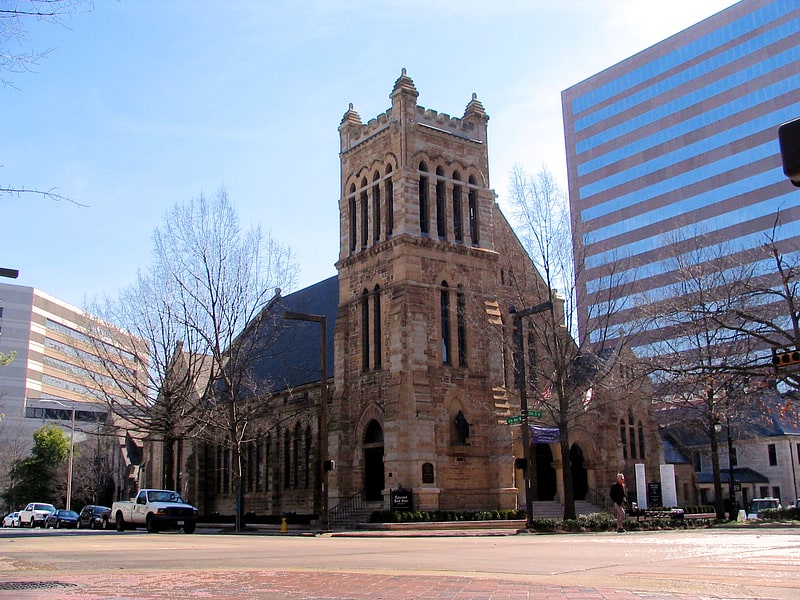
Episcopal church in Birmingham, Alabama. The Cathedral Church of the Advent in Birmingham, Alabama, is the see church of the Episcopal Diocese of Alabama. On March 30, 1983, the structure was added to the National Register of Historic Places as the Episcopal Church of the Advent.[27]
Address: 2017 6th Ave N, 35203 Birmingham (Northside)
Birmingham Civil Rights National Monument
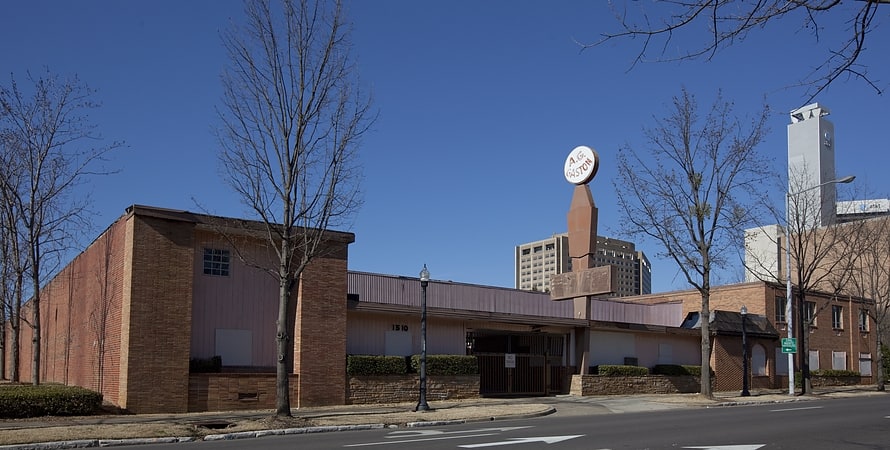
National monument in Birmingham, Alabama. The Birmingham Civil Rights National Monument is a United States National Monument in Birmingham, Alabama established in 2017 to preserve and commemorate the work of the Civil Rights Movement. The monument is administered by the National Park Service.[28]
Address: 520 16th St N, Birmingham (Northside)
Third Presbyterian Church
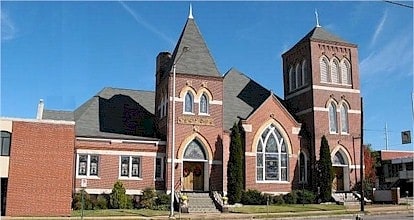
Presbyterian church in Birmingham, Alabama. The Third Presbyterian Church of Birmingham, Alabama is a Presbyterian church located on the city's Southside at 617 22nd Street South, at the corner of 7th Avenue South. It is a member congregation of the Presbyterian Church in America.[29]
Address: 617 22nd St S, 35233 Birmingham
Red Mountain Expressway Cut
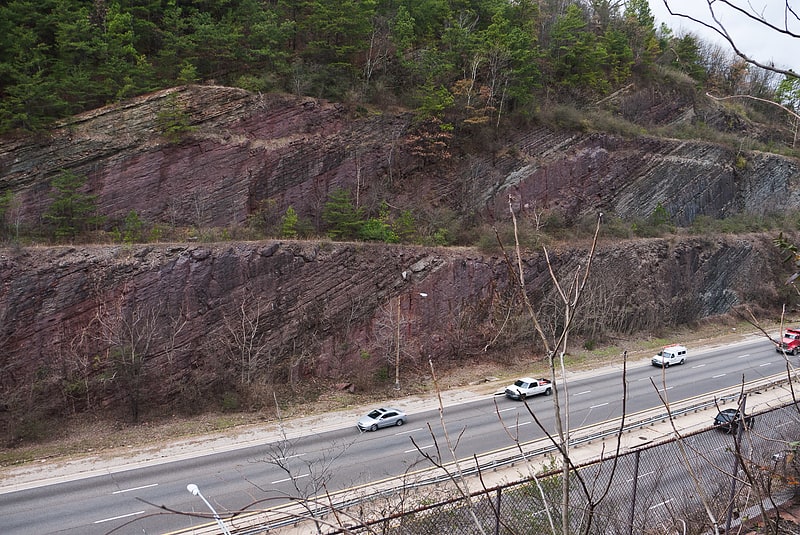
The Red Mountain Expressway Cut, also known as the Red Mountain Geological Cut, is a section of Red Mountain that was blasted and removed in the 1960s to allow the Red Mountain Expressway to enter downtown Birmingham, Alabama. This highway links Birmingham with its southern suburbs of Homewood, Mountain Brook, and Vestavia Hills. It has spurred suburban growth towards the south of Birmingham. This section also provides the route for U.S. Route 31 to the south and US 280 to the southeast.
The resultant cut exposes geological strata spanning millions of years (150 million years of geological time within 650 feet or 200 metres of exposure), including the red ore seam that spurred Birmingham's development. A new species of Lower Silurian (middle Llandovery epoch) phacopsid trilobite, Acaste birminghamensis, was first collected from exposures on Red Mountain. Named for the city, the new species was published in May 1972.
The cut was designated a National Natural Landmark in 1987.[30]
Address: Red Mountain Expy, 35211 Birmingham (Red Mountain)
Temple Emanu-El
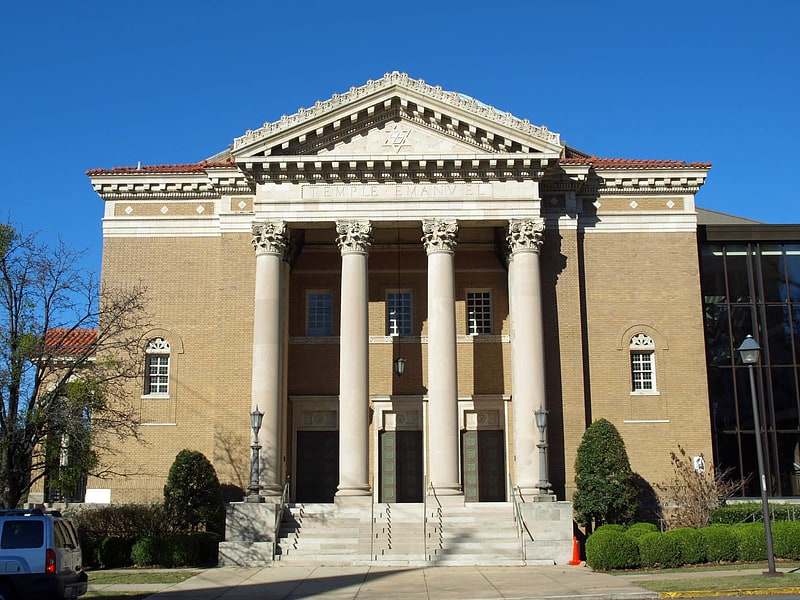
Reform synagogue in Birmingham, Alabama. Temple Emanu-El is a Reform Jewish congregation in Birmingham, Alabama.[31]
Address: 2100 Highland Ave S, 35205 Birmingham
Railroad Park
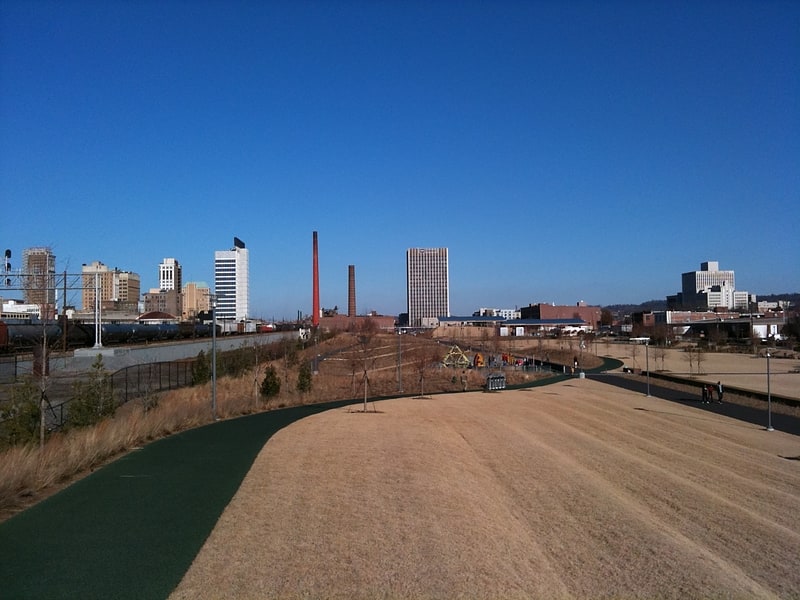
Park in Birmingham, Alabama. Railroad Park is a 19-acre park in Birmingham, Alabama, United States, that opened in the fall of 2010. It was designed by landscape architect Tom Leader and built by Birmingham-based Brasfield & Gorrie. The park lies immediately south of the Norfolk Southern and CSX rail lines through downtown Birmingham. It stretches from 14th Street to 18th Street along First Avenue South. UAB Hospital and Children's Hospital of Alabama are several blocks south of the park. The park is a public facility owned by the City of Birmingham and managed by the non-profit Railroad Park Foundation.
In 2016 Rotary Trail was opened, which connects Railroad Park to Sloss Furnaces through a pedestrian greenway.[32]
Address: 1600 1st Ave S, 35233-1703 Birmingham
Second Presbyterian Church

Second Presbyterian Church is a historic church at Tenth Avenue and Twelfth Street South in Birmingham, Alabama. It was built in 1901 and added to the National Register of Historic Places in 1986. It is now used as the University of Alabama at Birmingham honors house.[33]
First United Methodist Church
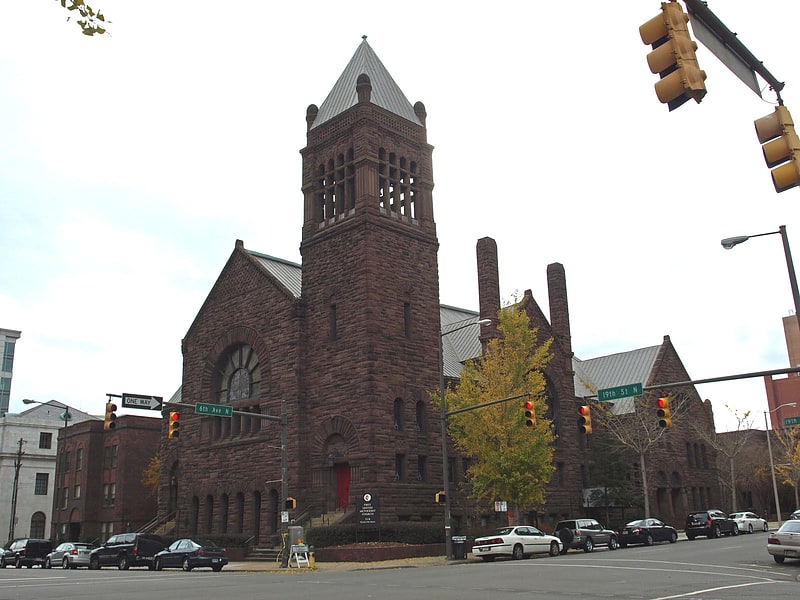
United methodist church in Birmingham, Alabama. First United Methodist Church is a historic church at 6th Ave. and 19th Street, North in Birmingham, Alabama. It was built in 1891 and added to the National Register of Historic Places in 1982.[34]
Address: 518 19th St N, 35203-2107 Birmingham (Northside)
Bethel Baptist Church
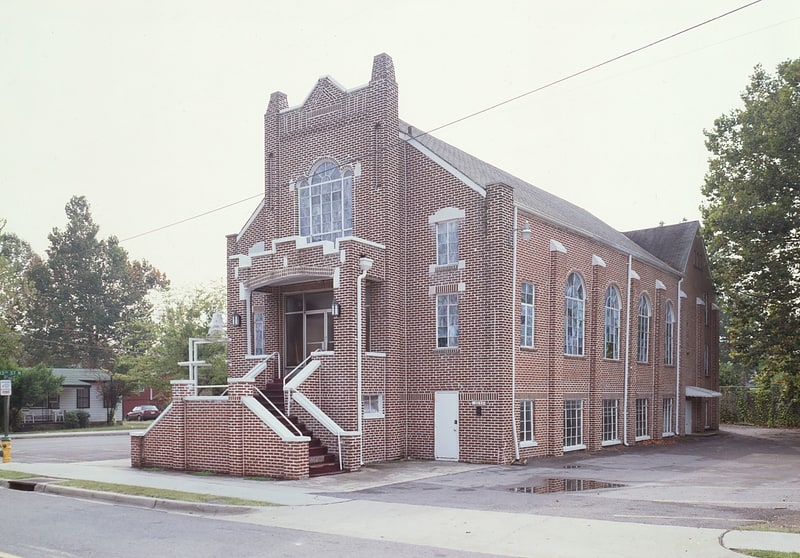
Historical landmark in Birmingham, Alabama. Bethel Baptist Church is a Baptist church in the Collegeville neighborhood of Birmingham, Alabama. The church served as headquarters from 1956 to 1961 for the Alabama Christian Movement for Human Rights, which was led by Fred Shuttlesworth and active in the Birmingham during the Civil Rights Movement. The ACMHR focused on legal and nonviolent direct action against segregated accommodations, transportation, schools and employment discrimination. It played a crucial role in the 1961 Freedom Ride that resulted in federal enforcement of U.S. Supreme Court and Interstate Commerce Commission rulings to desegregate public transportation.[35]
Address: 3200 28th Ave N, 35207-5116 Birmingham